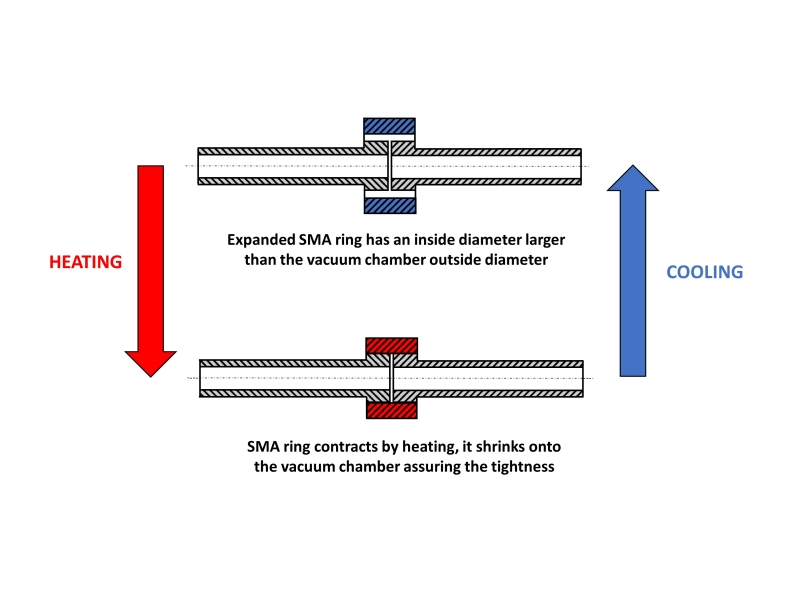A collaboration between CERN and the University of Calabria is developing a new connection device for vacuum chambers based on Shape Memory Alloy (SMA) rings, for future use in the High-Luminosity LHC (HL-LHC). The unique characteristics of these materials, able to memorise different shapes at high and low temperatures, are being exploited to create a high-tech solution for sealing the vacuum chambers of the upgraded accelerator.
In particle accelerators, beams circulate inside vacuum chambers connected by flanges - complex engineering components which ensure the integrity of the vacuum system. Currently, there are two types of flanges used in the LHC: standard “ConFlat” flanges, which are bolted together; and the quick conical connection flanges used on radioactive components (for example collimators), which need large and heavy chain clamps. Clamping or unclamping a flange is time-consuming and can result in a larger radiation dose to personnel in a radioactive environments. “A light compact flange that is easier to install and remove, possibly remotely, and that minimises the time of any intervention was what we were really looking for,” explains Paolo Chiggiato, Head of the Vacuum, Surfaces and Coatings (VSC) group. And the answer was SMAs.

“The shape memory effect is the ability of an SMA to ‘remember’ its original shape upon heating,” says Cédric Garion, a member of the VSC group. “This is possible under certain thermo-mechanical conditions, where particular microscopic crystallographic configurations occur (see box). At CERN, we are particularly interested in NiTi (Nickel-Titanium)-based alloys, which present very promising shape recovery capabilities.” Currently under development by CERN in collaboration with the Department of Mechanical, Energy and Management Engineering (DIMEG) of the University of Calabria (Italy), a NiTi-based connection device could provide a smart solution for easy installation and disconnection. SMA rings can have two sizes: a smaller, contracted version when heated, and a larger one when cooled down. “After certain thermo-mechanical treatments, when heated up, the SMA rings currently being studied (about 45 mm internal diameter and 8 mm thickness) contract, with a diameter variation of several millimeters!” explains Fabrizio Niccoli, of the University of Calabria, who is currently doing his PhD on this topic. “They could easily be installed at room temperature around the extremities of the chamber when they are slightly larger, and then heated up to get the contracted shape, clamping the vacuum chambers and assuring vacuum leak tightness. Tests at CERN have shown that a reproducible tightness below 10-10 mbar.l.s-1 is achieved. The SMA ring is removed by cooling it below room temperature, re-inducing its enlarged configuration so that it becomes loose enough to allow the technicians to open the pipes easily.”
This technology is being developed for the future HL-LHC, which will be operational in 2026. The luminosity of the HL-LHC will be a factor of 10 higher than that of the current LHC. The increased luminosity means that radioactivity will be higher at some points of the accelerator. The time spent in some parts of the tunnels will then need to be minimised as much as possible.
|
A change in crystallography  Left: the austenitic structure. Right: the martensitic structure. (Image: Fabrizio Niccoli) Under certain thermo-mechanical conditions, SMAs take on particular microscopic crystallographic configurations known as the martensitic and austenitic phases. The presence of either phase depends mainly on the temperature and/or the stresses applied. The austenitic phase is stable at high temperatures and low applied stresses and is characterised by a body-centered cubic cell, while the martensitic phase is stable at low temperatures and high applied stresses and has a distorted monoclinic cell. |

